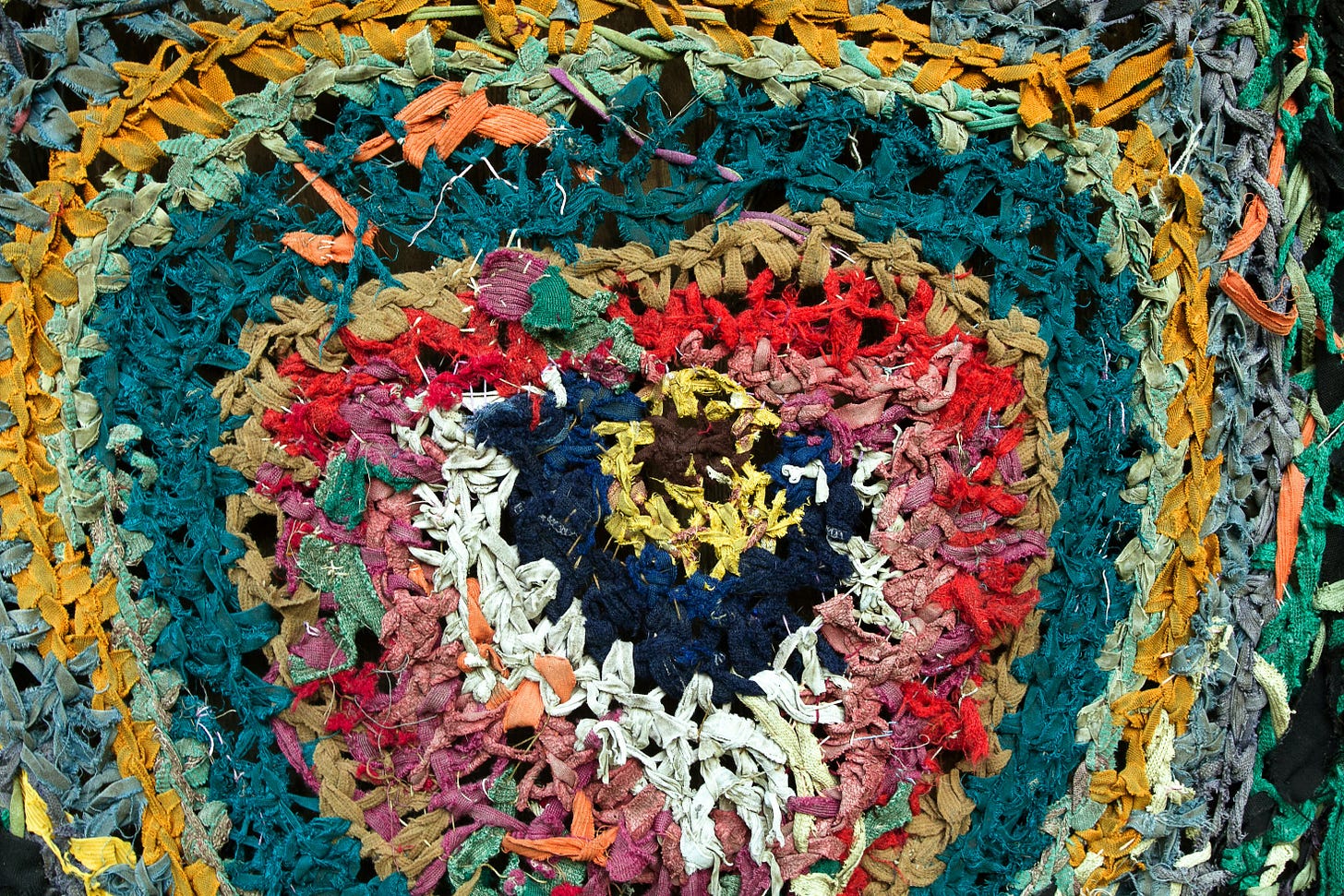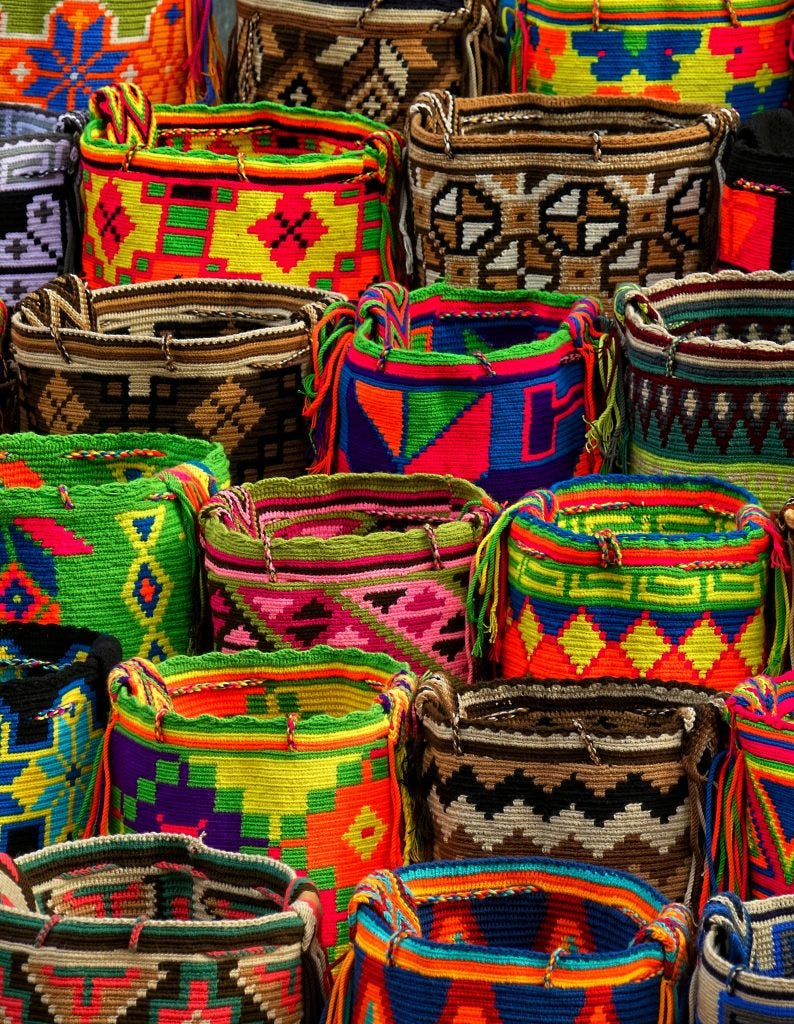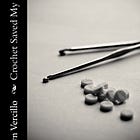5 Ways Rag Rug Weaving Improves Mental Health
Unraveling Stress: The Therapeutic Pathways of Creative Crafting
The first version of this article on slow crafting originally appeared on the PsychCentral blog Crafting to Heal which I wrote in 2019. I’ve updated it with additional information. I’ve added book recommendations and links to additional articles about the psychological and emotional benefits of weaving, as more exist now than when I first wrote this article.
There aren’t many (any?) books out there on how weaving improves mental health. Likewise, you won’t find a lot of books specifically about the mental health benefits of crochet, knitting, embroidery, woodworking, scrapbooking, or any other crafts.
Nevertheless, people are writing inside books about how crafting heals.
It’s subtle. You have to look for it. However, it’s there.
That’s why I often flip through craft books. I don’t just read books to follow patterns or create projects. I read craft books for crafts that I don’t do myself. Within those pages, I find so many examples of people using crafting to heal.
2024 Update: There are an increasing number of books that address the topic specifically, which I love to see. That said, I do continue to find that some of the best information about how craft heals comes from reading between the lines in various craft books that aren’t specific to the topic.
A Book About Rag Rug Weaving
For example, recently I read through some of the pages in “Weaving Western Sakiori” by Amanda Robinette. This is a very specific type of rag rug weaving. In fact, it’s a unique combination of modern Western weaving and ancient Japanese weaving.
The book is filled with rich information about the history of this style of weaving in Japan. Of course, it also has tutorials and projects for learning the skill yourself. But what I found most intriguing was a section called “Why Rag Weaving?”
Reading between the lines, what I find here is a summary of some of the ways weaving improves mental health.
5 Ways Rag Rug Weaving Improves Mental Health
Of course, there are benefits of crafting that extend past any specific craft. For example, weaving helps interrupt rumination in conditions including anxiety, depression, and PTSD. However, Robinette laid out five specific reasons that she chooses to weave with rags.
1. The Joy of Experimentation and Play
The first reason that Robinette gives is actually “to make beautiful things.” That, in itself, is beneficial to mental health.
In her book, “Joyful: The Surprising Power of Ordinary Things to Create Extraordinary Happiness”, Ingrid Fetell Lee explores an important question. She asks, “how do tangible things create an intangible feeling of joy?” So, in fact, having beautiful things can give us joy.
More than that, we feel good when we create beautiful things ourselves. We feel empowered. Our self-esteem goes up. This is all good for mental health.
However, Robinette actually seems to be saying more than that in this section of her book. She talks about how working with rags means that you don’t always know how the project will turn out. You have a plan in mind, but the colors aren’t always what you envisioned.
As a result, you have to experiment. You get the chance to imagine, play, and re-work things until they satisfy you. This stretches parts of our brain that we often don’t get the chance to use.
After all, how often do you do something rotely? All too often. Creative crafting allows you to play, which is something our brains need.
2. “The Joy of Creative Destruction”
I’m leaving that subtitle exactly as Robinette wrote it. It explains what she means perfectly.
With rag rug weaving, you first have to take apart the rags. You have to destroy them before you can create something new.
Robinette says that “there is something oddly satisfying” in this. I think what’s satisfying is the way that the act of doing this works on us subtly as a metaphor. It’s the phoenix rising from the ashes.
Often, when we craft, we are working through something in our minds. When we see that we can destroy in order to create, we see possibility. It’s not just that we see it in the rags; we see it in our own mental health, in our own actions, in our own lives.
3. The Pleasure of Limited Choices
Robinette notes that working with rags creates boundaries on what you can make. If you open yourself to an array of new fibers, then your choices open up. However, working within the creative limits of one material actually has benefits.
Sometimes having too many options is paralyzing. Sometimes we need boundaries to be our most creative selves. (This is another mental health metaphor.)
4. Rag Rug Weaving is Eco-Friendly
When you work with recycled materials, you are being kind to the earth. Arguably, being more in touch with the earth improves mental health. That’s because:
You’re living in line with your personal values.
You feel intertwined with everything. It feels like your choices matter.
Working with our hands at a slow pace brings us back in touch with ourselves.
If we see the value in a used item, then we treat all things with more value. This includes ourselves.
5. It Connects us With Tradition
Do you know how many generations before you were weavers? There were many.
Something magical happens when you perform a craft that others have done in the same way for centuries. It’s as if you step into a timeless place. You become part of something so much bigger than you are.
In this way, weaving connects you to makers of the past. Connection offers a sense of belonging. This heals so many of our inner wounds that cause issues with mental health.
2024 Update: Books and Articles about Benefits of Weaving
I was thrilled to discover a 2023 workbook on Amazon by Ellie Fisher called Weaving as Art Therapy for Beginners: A Self-Care Workbook to Ease Anxiety, Stress, and Depression. It discusses “9 therapeutic weaving activities, each with a specific aim—including stress relief, letting go of past hurt, boosting self-love, and avoiding burnout” which reminds me a lot of my book, Hook to Heal, in which there are ten chapters with ten exercises each themed to using crochet for specific aims including mindfulness, self-esteem building, balance, improving relationships and more.
Amazon also lists these features of Fisher’s book:
How to make and dress a simple frame loom to create your weaving projects on.
Popular loom weaving techniques, such as twining, tabby, multiple warp plain weave, Rya knots, soumak, warp wrapping, and finishing, with easy-to-follow step-by-step instructions for each.
6 off-loom weaving techniques, several simply requiring tools from nature—from fallen branches to beach stones.
5 ways to weave on a budget, doing your bit for sustainability along the way.
These all speak to slow crafting. Read more on that:
There is also an older, more academic book, which I’ve not yet read that looks interesting:
Using Textile Arts and Handcrafts in Therapy with Women: Weaving Lives Back Together is described on Amazon in part: “Reviewing the role of textile-based handcrafts in the lives of women today, and integrating the life issues they face with the therapeutic making of fibre art, the book covers everything from the psychology of this therapeutic approach to how to carry it out effectively with a wide range of clients.”
In addition to these books, here are some articles I’ve found on the benefits of weaving:
Woven Flow: Weaving As Meditation. “Sarah has found that weaving calms her and can help her with anxiety when done intentionally. Read what she has discovered about weaving's effect on herself and others.”
The Power of Calm: The Benefits of Weaving. “This ancestral art is, at its core, a comfortable way to find cozy time for oneself and ensure a good mental health.”
Historian Michael Skopp encourages weaving and crafts for those struggling with mental illness. “Weaving helps Skopp deal with his PTSD. His art becomes a therapy that gives him relief from his anxieties.”
How textile artist Molly Kent weaves mental health into her work. “Having been diagnosed with CPTSD, Molly discovered that her need to create was integral to her mental health, and began exploring themes around wellbeing in her work.”
If you read this far, perhaps you liked the work. The work does take work. It only continues with support, so please consider subscribing. My annual rate starts at $10 per year.















